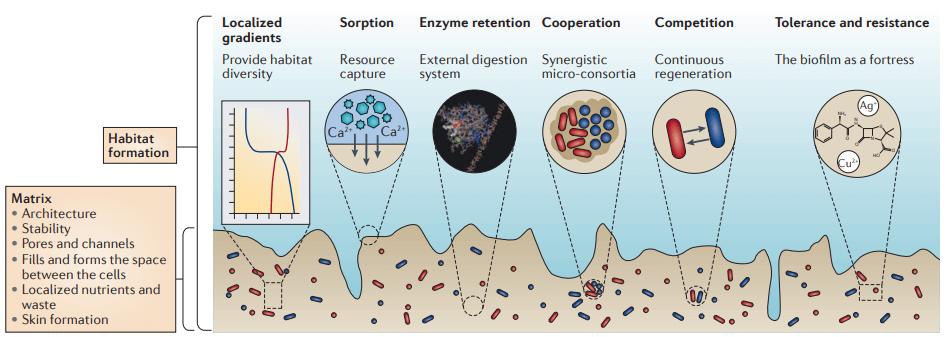Biofilm Characterization
Biofilms Identification
Early microbiology believed that microorganisms were mainly characterized by floating, free-suspending cells, and they were described according to their growth characteristics in nutrient-rich media. Modern biology has gradually elucidated the microbial community in the form of biofilms. Biofilms consist of microbial community formation and its "support" embedded in an extracellular polymer (EPS) matrix. Biofilm-related cells can be distinguished from their suspended counterpart cells by the production of EPS matrix, the reduction of growth rate, and the up-regulation and down-regulation of specific genes. Clinically relevant biofilms are sessile microbial communities located on natural or artificial surfaces of the human body and wrapped in an EPS matrix. When constructing biofilms, cells are physiologically adapted to withstand the lethal effects of various environmental stress conditions. Compared with freely living cells, bacteria in biofilms exhibit a set of "emergency characteristics" that are completely different from those of freely living bacterial cells, that is, bacterial cells in biofilms resist harsh environments such as disinfectants and antibacterial agents. This interesting "protective measure" will bring a series of problems to food processing and clinical practice. FISH technology facilitates the direct localization and in situ identification of biofilms in the clinical and food industries.
 Fig 1. Emergent properties of biofilms and habitat formation. (Flemming H C, et al. 2016)
Fig 1. Emergent properties of biofilms and habitat formation. (Flemming H C, et al. 2016)
Technical Advantages
FISH provides several advantages specifically for biofilm detection:
- FISH can analyze samples that remain culture-negative (a typical feature of biofilms);
- FISH can distinguish between planting and pollution of equipment;
- FISH can show the spatial distribution and co-aggregation of microorganisms in biofilms, such as co-localization in biofilms;
- Compared with PCR and microbiome analysis, which mainly provides a list of microorganisms, FISH combined with digital image analysis can quantitatively measure and identify key biofilm species;
Biofilm Characterization FISH Services
Our biofilm bacterial composition characterization service is a pioneering testing service. This service can help food processing companies, medical device manufacturers, laboratories, hospitals, and other places with high requirements for microbial control to provide identification services for the characterization of microorganisms in biofilms on equipment. Our service process includes the steps of sampling, sample submission, FISH hybridization, microscopy service and data analysis. The sampling process can be completed by the customer, and our experts will provide relevant technical support. After the sample is mailed to our laboratory, a preliminary quality inspection will be carried out. Usually, we will issue a sample quality inspection report. Then our microbiological testing department will complete the relevant FISH analysis test and harvest high-definition images. Finally, the bioinformatics team excavated the data and gave an identification report. This is a qualitative and relatively quantitative testing service, and the number of detectable targets is usually more than five. With the information obtained through this service, customers can make targeted decisions.
 Fig 2. The target customer group for FISH analysis of biofilm microorganisms.
Fig 2. The target customer group for FISH analysis of biofilm microorganisms.
Creative Bioarray provides a wide range of in-situ analysis and identification services of biofilm microorganisms to help our customers complete the formulation of related strategies. Through fast FISH hybridization analysis, you will get the best solution and benefit from our technical expertise and complete platform. If you are interested in our FISH service for biofilm microbial identification, please contact us for cooperation. We look forward to cooperating with you in the near future.
References
- Flemming H C, Wingender J, Szewzyk U, et al. Biofilms: an emergent form of bacterial life[J]. Nature Reviews Microbiology, 2016, 14(9): 563-575.
- Donlan R M. Biofilms: microbial life on surfaces[J]. Emerging infectious diseases, 2002, 8(9): 881.
All products and services on this website are only suitable for non-medical purposes.


 Fig 1. Emergent properties of biofilms and habitat formation. (Flemming H C, et al. 2016)
Fig 1. Emergent properties of biofilms and habitat formation. (Flemming H C, et al. 2016) Fig 2. The target customer group for FISH analysis of biofilm microorganisms.
Fig 2. The target customer group for FISH analysis of biofilm microorganisms.


